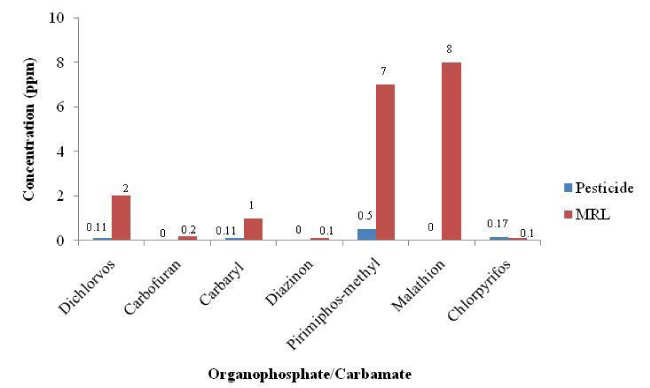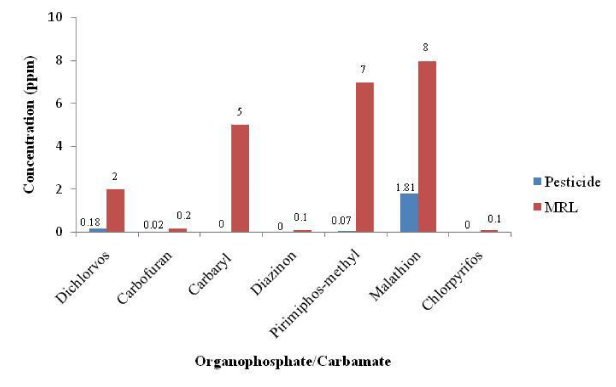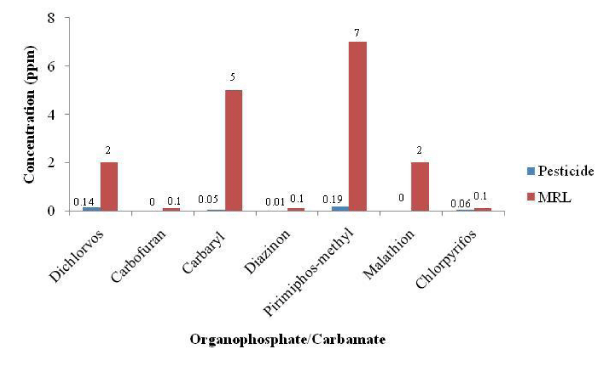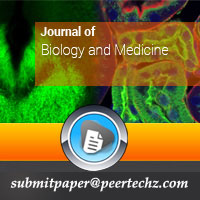Journal of Biology and Medicine
Quantification of Organophosphate and Carbamate residue on stored grains in Ondo State, Nigeria
Akinneye Joseph O*, Adedolapo AO and Adesina Femi P
Cite this as
Akinneye Joseph O, Adedolapo AO, Adesina Femi P (2018) Quantification of Organophosphate and Carbamate residue on stored grains in Ondo State, Nigeria. J Biol Med 2(1): 001-006. DOI: 10.17352/jbm.000003Pesticides are beneficial in reducing the loss cause by insect infestation on grains but its toxicity and persistence in the environment is of health concern. Cereal grains preserved with insecticide are considered to be good for consumption if it’s active content substances of insecticide do not exceed the maximum residue limits (MRLs). The objective of this research is to quantify the residue of chlorinated pesticide content of the four grain samples and compare their residues content with FAO/WHO MRLs. Dichlorvos was found in all the bean samples with quantities ranged from 0.06 - 0.212 ppm and there was no significant difference (p >0.05) between location 2 (0.08 ppm) and Location 3 (0.06 ppm). Likewise on rice, dichorvos was present in all locations, ranged from 0.04 to 0.37 ppm and its residues detected in each location were significantly different (p < 0.05) from one another. For wheat, carbaryl was detected in location 4 (0.21 ppm) only, likewise pirimiphos-methyl in location 2 (0.75 ppm). Carbofuran, malathion, chlorpyrifos and parathion were not detected in any of the maize samples. Pirimiphos-methyl had the highest concentration in the beans sample (0.5 ppm) and had the lowest concentration in rice (0.07 ppm). Wheat had the highest number of insecticide residue and followed by rice sample. Almost 99% of the pesticides monitored were below their MRL, while only chlorpyrifos concentration slightly exceeded its maximum residue limit in bean. Nevertheless, their detection further attests to their persistence and efforts should still be geared towards appropriate uses of pesticides.
Abbreviations
MRL : Maximum Residue Limits; FAO: Food and Agriculture Organisation; WHO: World Health Organisation
Introduction
Agriculture has always been a very important activity in the Nigerian economy, providing gainful employment and livelihood for about 70% of the populace [1]. Challenges of agriculture in Nigeria can be grouped into biotic and abiotic factors. One of the biotic factors is insect pests or diseases which attack crops either on the field or in storage and therefore affect crop production, contributing to low productivity. Solving this challenge has attracted the increase use of pesticides since 1940s [2].
Pesticides are substances used to kill, repel, or control certain forms of plant or animal life that are considered to be pest [3]. Nowadays, more than 1100 pesticides are used in various combinations and at different stages of cultivation and during postharvest storage to protect crops against a range of pests and fungi and/or to provide quality preservation and its use in agriculture constitute 75% world usage [4]. Pesticides belong to different chemical classes but the major ones are organochlorines, organophosphates, carbamates and pyrethroids [5]. Apart from benefits derive from using pesticide, there are also drawbacks to it usage has it poses a serious havoc to the environment [6]. Being persistent in the environment, their accumulations in the food chain, their sub-acute and chronic toxicity are detrimental to human and animal health [7,8].
Organophosphate and carbamate are among the pesticide that are widely used in store and warehouses to protect grains against insect infestation, and these pesticides has long insecticidal activity persistence. It had been reported that organophosphates are very toxic and more often involved in acute poisoning than other classes of pesticides [9,10], while carbamates on the other hand are less toxic but very effective as insecticide [5]. Cereal grain is considered to be good for consumption not only if it is free from foreign materials, smell, unusual colour, mycotoxins and contaminations with live pests, but also when the concentration of active substances of pesticides does not exceed the maximum residue limits (MRLs). European Union [11], and FAO/WHO [12], set a maximum residue limits (MRLs) in cereals and feeding stuff, among other compounds. Hence, the objective of this research is to quantify the residue of organophosphate and carbamate pesticide content of the four grain samples and compare their residues content with FAO/WHO MRLs.
Materials and Methods
Study area
Akure is located in south – western of Nigeria, a largest city and capital of Ondo State. It is located between latitudes 070 161 and 070 181 N and longitudes 050 091 and 050 11I E.
Collection of samples
Grain Samples were maize (Zea mays L), brown beans (Vigna unguiculata) wheat (Triticum aestivum) and Rice (Oryza sativa). Grains were purchased from four markets across Akure, Ondo State. The markets are represented as follows: Location 1 – Oba market, Location 2 – Isikan market, Location 3 – Nepa market and Location 4 – Shasha market. To obtain random sampling, about 200g were purchased from five different sales outlets. The samples were code-named and stored in glass bottles with tight covers to protect them from moisture and contamination. They were then stored in the refrigerator 40C until when ready for use.
Chemicals
All chemicals were of analytical grade and 99% purity. Reagents used include anhydrous sodium sulphate, ethyl acetate, n-hexane and all pesticides tested (Fisher Scientific, Allentown UK). The solvents were re-distilled in all-glass apparatus before use.
Preparation of samples
The samples were cleaned by picking out stones and other extraneous materials. Each market sample from different outlets was thoroughly mixed and a 200.0g portion was taken and milled to 20 mesh particle size to produce a good homogenate. The milled samples were then stored in glass bottles with appropriate labels in a refrigerator at 40C. Duplicate portions (200.0g) of the samples were stored as whole grains in labelled glass bottles in the refrigerator as backup samples.
Extraction and clean-up of samples
Extraction of samples for the analysis was according to the methods of Sharif et al. and Wei-Guo et al. [13], with slight modifications. The milled sample was properly mixed and 2.0g was weighed into a sample vial. 1.0g of sodium sulphate that has been previously heated at 6500C for one hour in a furnace and stored in a desiccator was added to absorb any moisture present. Ethyl acetate (10.0ml) was added to the vial. The mixture was mixed for 5min by shaking and then allowed to stand for 45min. It was mixed again and centrifuged for 5min. at 2500rpm. The supernatant was carefully transferred into a flask. The residue was further extracted twice as described above, using 10.0ml ethyl acetate each time. The supernatants were combined and reduced to about 5ml using a rotary evaporator at 35oC. The solution was then transferred into a sample tube. This was then taken for cleanup to remove other unwanted co-extractives.
Silica gel column chromatography (Clean up)
The chromatographic column (20cmx8mm I.D.) was packed with cotton wool to 10ml point on the syringe; 1g of anhydrous sodium sulphate was placed at the top of the column followed by 2g of Activated Silica gel and another layer of 1.0g anhydrous Sodium Sulphate to absorb any moisture present in the sample or the solvent. The column was conditioned with 5ml of the eluting solvent mixture made up of ethyl acetate and hexane (50:50). The sample extract (1ml) was loaded on the cartridge. The sample tube was rinsed three times with 1.0ml eluting solvent, and the rinses added to the column. The sample was then eluted with 5.0ml of the same solvent mixture into a receiving glass tube. The column was rinsed with another 3.0ml of the eluting solvent mixture into the same receiving glass tube. The eluant was then evaporated to dryness and the residue reconstituted in 1.0ml ethyl acetate for GC-MS analysis.
Organophosphate and carbamate: Dichlorvos, Carbofuran, Carbaryl, Diazinon, Pirimiphos-methyl. Malathion, Chlorpyrifos and Parathion.
Preparation of calibration curves
Stock solutions of pure standards of organochlorine were prepared and then serially diluted to produce different concentrations of the pesticides. Stock standard solutions were stored in amber coloured bottles at 40C while working standard solutions were prepared fresh before use. Standard solutions of the pesticides were run on GC/MS under the set chromatographic conditions and mean peak areas were plotted against concentrations to obtain calibration curves of individual pesticides.
Data analysis
All data were subjected to statistical analysis of Duncan New Multiple Range Test (DNMRT) at 0.05 level of significance using Statistical Package for Social Science version 21.
Result
Concentration of organophosphate and carbamate pesticides in beans samples
The concentration of organophosphate and carbamate pesticide in beans samples is presented in table 1. The four markets surveyed in this research are represented as follows: Location 1 represents Oja-Oba, Location 2 represents Isikan market, Location 3 represents Nepa Market and Location 4 represents Shasha market. Dichlorvos was found in all samples with quantities ranging from 0.06 - 0.212 ppm and there was no significant difference (p >0.05) between location 2 (0.08 ppm) and Location 3 (0.06 ppm). Carbaryl was not found at Location 2 and Location 4 samples but was detected in location 1 (0.25 ppm) and location 3 (0.19 ppm) samples, which were significantly different (p<0.05). Diazinon (0.67 ppm) was found only in the beans sample from Location 4. Only the samples from Location 3 contained no chlorpyrifos of all the samples and its residue was not significantly different (p >0.05) between location 1 (0.12 ppm) and location 2 (0.14 ppm). Carbofuran, pirimiphos-methyl, malathion and parathion were however not detected in any of the beans sample analyzed. Location 1 and location 2 contained much pesticide residues than the other locations.
Organophosphate and carbamate pesticides in rice samples
Table 2 showed the concentration of the pesticides in Rice samples. Carbaryl, Diazinon and Chlorpyrifos were not detected in any of the locations. Dichorvos was present in all rice samples analyzed, ranged from 0.04 to 0.37 ppm and its residue detected in each location was significantly different (p < 0.05) from one another. Carbofuran was only found in location 3 (0.08 ppm). Pirimiphos-methyl in samples from location 1 (0.12 ppm) was significantly different (p < 0.05) from location 4 (1.74 ppm). Likewise, significant difference existed in malathion residue between rice samples from location 2 (2.78 ppm) and location 3 (4.82 ppm), while it was not detected in other locations. Parathion was detected only in location 3 (1.25 ppm). Location 3 was recorded to contained the highest number of pesticide detected in rice samples
Organophosphate and carbamate pesticides in the wheat samples
Carbofuran and Malathiom were not detected in any of the wheat samples (Table 3). Dichlorvos detected ranges from 0.11 to 0.17 ppm with significant difference (p < 0.05) among locations. Carbaryl was detected in location 4 (0.21 ppm) only, likewise Pirimiphos-methyl in location 2 (0.75 ppm). It was only location 1 (0.14 ppm) and location 2 (0.1 ppm) that contained chlorpyrifos and were Parathion in location 2 (1.82 ppm) and location 3 (1.26 ppm) were significantly different (p < 0.05). The wheat sample from Location 2 had the highest number and quantity of residues because four pesticides were detected in it, while the sample from Location 4 contained three different pesticides.
Organophosphate and carbamate pesticides in the maize samples
It was showed in table 4 that carbofuran, malathion, Chlorpyrifos and Parathion were not detected in any of the maize samples. Dichlorvos was detected in location 1 (0.15 ppm) and location 2 (0.18 ppm) with significant different (p < 0.05). It was only in location 1 (0.19 ppm and 0.04 ppm) that carbaryl and diazinon were detected respectively. There was significant different (p < 0.05) among pirimiphos-methyl residue detected on maize samples from all locations observed and it ranged from 0.00 ppm to 2.43 ppm. That there was no pesticide residues found in maize samples from location 4.
Concentration of organochlorine pesticides in grain samples
The results of the analysis of organophosphate and carbamate pesticides in the grains from the four markets are presented in table 5. Concentration of Dichlorvos ranged from 0.08- 0.18 ppm, with Rice samples having the highest concentration and Rice (0.18 ppm) was significantly difference (p < 0.05) from Bean (0.11 ppm) and Maize (0.08 ppm). Carbofuran was not detected in beans, wheat and maize samples but rice had a concentration of 0.02 ppm. Carbaryl was not detected in Rice but its concentration in Bean (0.11 ppm) was significantly different (p < 0.05) from Wheat (0.05 ppm) and Maize (0.05 ppm). For Diazinon, concentration of 0.01ppm was detected in both wheat and maize samples while it was not detected in beans and rice samples. Pirimiphos-methyl had the highest concentration in the beans sample (0.5 ppm) and had the lowest concentration in rice (0.07 ppm). Malathion was detected only in Rice (1.8 ppm) and chlorpyrifos detected in Beans (0.17 ppm) and Wheat (0.05 ppm) samples were significant different (p < 0.05) from each another. Concentration of parathion found in Rice (0.31 ppm) was significantly difference (p < 0.05) from Wheat (0.45 ppm) but it was not detected in the beans and maize. Wheat had the highest number of insecticide residue and followed by rice sample.
Maximum Residue Limit (MRL) of Organochlorine Pesticides for each grain in ppm
Figures 1–4 are charts showing the comparison between the FAO maximum residue limit and the concentrations of the organophosphate and carbamate pesticide residues tested in this experiment. Almost 99% of the pesticide monitored below their MRL, while only chlorpyrifos concentration slightly exceeded its maximum residue limit in bean.
Discussion
Many of the organophosphate and carbamate pesticides tested were found to be absent in some grains sample. For example, Diazinon was not found in the beans and rice samples while malathion, parathion chlorpyrifos and carbofuran were absent in the maize samples. Likewise, carbaryl was also found absent in rice. This shows that these pesticides were not used at all or that they were used according to standard specification on these grains.
Dichlorvos and Pirimiphos-methyl were detected in all four sample grains examined in this study. This was in accordance with the result of Ogah and Coker that recorded Pirimiphos-methyl as the most frequently encountered, occurring in 43% of samples studied [5]. Also, Fleurat-Lessard et al. reported pirimiphos-methyl as a widely used pesticide in the major grain-producing countries to protect against insect attack [14]. Many researchers have studied stored grain and reported the presence of pesticide residue. Jagadish et al. evaluated the pesticide residue in rice, wheat and pulses, and found chloropyrifos to be the most commonly detected pesticide in cereals and pulses from their studied area [15].
The low levels of organophosphate and carbamate residues found in this current study may be due to good storage practices and good pesticide application to prevent insect infestation. Majority of grains are often stored for a long time at ambient temperatures and with this, if proper management is not done, there will be insect infestation. Grains are highly susceptible to infestation by pests, so they are consequently often subjected to post-harvest treatment with pesticides to maintain good quality during storage and to avoid economic losses. Other storage practice such as sanitation, frequent monitoring and aeration can reduce the quantity of pesticide treatment needed to prevent stored grains from insect attack.
The concentrations obtained from the study were compared with the FAO/WHO maximum residue limit for each of the grains. The results obtained showed concentration level of about 99% of the organophosphate and carbamate to have below the maximum residue limit set by FAO/WHO in cereals. Sawaya et al. determined the residue levels of organophosphate, carbamate and other pesticide residues in food items of the Kuwait population [16], the residues found were also below the acceptable limits. If a pesticide residue is found to exceed the MRL in any food, such a food commodity is said to be unsafe for consumption [12] and therefore, be rejected from international trade for not meeting international standards or standards of the receiving country.
Consumption of grains with pesticide residue above the stipulated maximum residue limit may result in accumulation of such chemicals in the body, which could eventually lead to adverse health effect. Organophosphate and carbamate have been found to cause neurodevelopmental toxicity in human [17]. Additive or synergistic effects of accumulated chemicals in the body can make pesticides that were detected to be safe for consumption before, to eventually pose health hazards [18]. Quantity of such food consumed, length of time for consumption [19] and toxicity of such residue also determine their effect on human or animal body.
Conclusion
The amount of organophospahate and carbamate pesticide residues detected in grains from Akure, Ondo State, Nigeria showed that the use of these particular pesticides were monitored as their residual level below MRL. The detection of some of these pesticides, are still of health concern as the accumulation over time will lead to medical issues. This further attests to their persistence and efforts should still be geared towards appropriate uses of pesticides.
- (2016) National Open University of Nigeria Stored Produce Protection. Published by National Open University of Nigeria. ISBN: 976-057-078-7. Link: https://tinyurl.com/y7gj3f5z
- Kolani L, Mawussi G, Devault DA, Sanda K (2017). Organochlorine Pesticide Residues in Agricultural Soils from Région Des Plateaux in Togo. Rev. Int. Contam. Ambie 33: 33 – 42. Link: https://tinyurl.com/y7d6jbvs
- (2013) National Institute of Environmental Health Sciences Pesticides. Link: https://tinyurl.com/ychwq3xp
- Naylor REL (2003) Crop health – responding to weed, diseases and pests. In: The Agricultural 20th Notebook, 20 Edition; Editted by Richard J. Soffe, Blackwell Science Ltd. Oxford, UK 213-230.
- Ogah CO, Coker HB (2012) Quantification of Organophosphate and Carbamate Pesticide Residues in Maize. Journal of Applied Pharmaceutical Science 2: 093-097. Link: https://tinyurl.com/yb2ew62g
- Akinneye JO, Adedire CO, Arannilewa ST (2006) Potential of Cleisthopholis patens Elliot as a maize protectant against the stored product moth, Plodia Interpunctella (Hubner) (Lepidoptera; Pyralidae). African Journal of Biotechnology 5: 2510 - 2515. Link: https://tinyurl.com/yasgoogt
- Leong KH, Tan LB, Mustafa AM (2007) Contamination levels of selected organochlorine and organophosphate pesticides in the Selangor River, Malaysia between 2002 and 2003. Chemosphere 66: 1153-1159. Link: https://tinyurl.com/y7fxupgm
- El-Shahawia MS, Hamza A, Bashammakh AS, AlSaggaf WT (2010) an overview on the accumulation, distribution, transformations, toxicity and analytical methods for the monitoring of persistent organic pollutants. Talanta 80: 1587-1597. Link: https://tinyurl.com/y8peadkp
- Collins DA (2006) A review of alternatives to organophosphorus compounds for the control storage mites. Journal of Stored Produces Research 42: 395-426. Link: https://tinyurl.com/y9lbblrf
- Mansour SA (2004) Pesticide exposure – Egyptian scene. Toxicology 198: 91-115. Link: https://tinyurl.com/y7v4as6t
- (2002) European Union DIRECTIVE 2002/32/EC of the European Parliament and of the Council of May 7. 2002 on undesirable substances in animal feed off. J. Eur. Comm. Link: https://tinyurl.com/y8udavqt
- (2013) FAO/WHO Pesticide residues in food and feed: maximum residual limits. Codex alimentarius.net/pesters/data/pesticides/details.
- Sharif Z, Man, YB, Hamid, NS, Keat, CC (2006) Determination of organochlorine and pyrethroid pesticides in fruits and vegetables using solid phase extraction clean-up cartridges. Journal of Chromatography A 1127: 254-261. Link: https://tinyurl.com/ybzhooot
- Fleurat-Lessard F, Chaurand M, Marchegay G, Abecassis J (2007) Effects of processing on the distribution of pirimiphos-methyl residues in milling fractions of durum wheat. Journal of Stored Produce Research 43: 384–395. Link: https://tinyurl.com/yaqgub3j
- Jagadish GK, Jaylakshmi SK, Sreeramulu, K (2015) Evaluation of pesticide residue in rice, wheat and pulses of Bidar district Karnataka, India. Biological Sciences and Pharmaceutical Research 3:100-106. Link: https://tinyurl.com/ybfpmd4p
- Sawaya W, Al-Awadh FA, Saeed T, Al-Omair A, Hussain AH et al. (2000) Dietary intake of organophosphate pesticides in Kuwait. Food Chemistry 89: 331–338. Link: https://tinyurl.com/y9whhu82
- Bjørling-Poulsen M, Andersen HR, Grandjean P (2008) Potential developmental neurotoxicity of pesticides used in Europe. Environmental Health 7: 50. Link: https://tinyurl.com/y7mfpm6z
- Ogah CO, Tettey J, Coker HB, Adepoju-Bello AA (2012) Analysis of Organochlorine pesticide residues in beans from markets in Lagos State, Nigeria. West African Journal of Pharmacy 23: 60–68. Link: https://tinyurl.com/y8t9meej
- Petersen B J (2000) Pesticide residues in food: Problems and data needs. Regulatory Toxicology and Pharmacology 31: 297-299. Link: https://tinyurl.com/yahjujkx
Article Alerts
Subscribe to our articles alerts and stay tuned.
 This work is licensed under a Creative Commons Attribution 4.0 International License.
This work is licensed under a Creative Commons Attribution 4.0 International License.





 Save to Mendeley
Save to Mendeley
